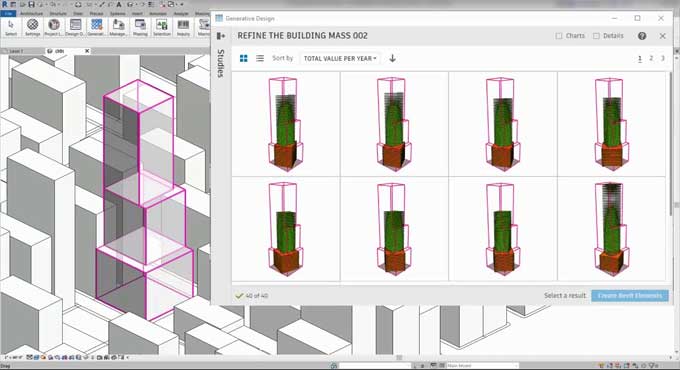Revit and Generative Design: Empowering Architecture with Algorithmic Innovation
Tweet
Technological breakthroughs continue to affect the way we conceptualise, plan, and create buildings in the ever-changing world of architecture and design. The integration of Generative Design with Autodesk's Revit software is one of the most significant advancements, revolutionising the way architects and engineers approach the design process. This strong mix taps into the power of algorithms to develop optimised, inventive, and long-lasting solutions.
What are BIM and Generative Design?
The use of Building Information Modeling (BIM) software has revolutionized the design and construction of buildings. It allows users to create detailed 3D models of buildings using Revit, one of the most popular BIM software packages.
The concept of generative design is a new technology that generates designs using algorithms. Architects and engineers will be able to design buildings using this technology in a completely new way. An architect or engineer can create efficient, sustainable, and appealing designs by combining Revit and generative design.
How do Revit and Generative Design Work Together?
In generative design and Revit, there are several ways in which they can be combined. The initial design of a building can be created using Revit. It is possible to export the initial design to generative design software once it has been created. A variety of design options will then be generated by generative design software.
After evaluating the different design options, the architect or engineer can select the most suitable one. After the design is selected, it can be imported back into Revit, where it can be further refined and developed.
The integration of Generative Design with Revit enables architects to create and analyse a wide range of design solutions based on particular performance objectives. It enables the development of more efficient and optimised designs that conform to sustainable practices while also meeting project restrictions. Architects may reinvent architectural possibilities, optimise spatial layouts, and investigate innovative material uses using this synergy.
Unleashing the Power of Algorithms in Design
Enhanced Design Exploration
Generative Design allows architects to explore a vast array of design alternatives, many of which would be challenging or even impossible to conceive using traditional methods. By considering a multitude of options, architects can identify creative solutions that optimize factors like energy efficiency, structural integrity, and spatial comfort.
Data-Driven Decision Making
Generative Design leverages data and analytics to inform design decisions. By integrating performance data, environmental factors, and material properties into the algorithm, architects can ensure that the generated designs are not just aesthetically pleasing but also meet specific performance criteria and sustainability targets.
Sustainable Design Solutions
The power of algorithms enables architects to design with sustainability in mind. Generative Design can analyze various energy-efficient strategies, material combinations, and passive design elements to create buildings with reduced environmental impact.
Optimal Space Utilization
Generative Design can optimize spatial layouts to make the most efficient use of available space. Whether it is designing a functional office layout or an urban development plan, the algorithm can find the best arrangement that maximizes usability and user experience.
Iterative Refinement
Generative Design operates in an iterative process, refining the design options based on feedback and evaluation. This allows architects to explore and refine design concepts continually, leading to increasingly optimized and sophisticated solutions.
Customization and Personalization
With Generative Design, architects can tailor designs to meet individual project requirements and specific user preferences. The algorithm can adapt to unique design constraints, accommodating specific site conditions, local regulations, and client preferences.
Collaborative Design Process
Generative Design supports a collaborative approach to design. Architects can work closely with clients, stakeholders, and interdisciplinary teams to define objectives, explore design alternatives, and make informed decisions. The algorithm serves as a tool for enhanced communication and collective decision-making.
Integration with Fabrication Technologies
Generative Design can seamlessly integrate with advanced fabrication technologies such as 3D printing, robotic manufacturing, and CNC milling. This integration enables architects to translate complex algorithmic designs into physical prototypes and finished structures with precision and efficiency, opening up new possibilities for architectural expression.
Continuous Learning and Improvement
Generative Design algorithms have the ability to learn from feedback and data, enabling them to continually improve and refine design outcomes over time. By analyzing the performance and feedback of past designs, architects can feed this knowledge back into the algorithm, enhancing its capabilities and producing increasingly optimized solutions.
Optimized Performance
By integrating performance-based criteria into the Generative Design process, architects can create designs that optimize various factors such as energy consumption, thermal comfort, daylighting, acoustics, and structural integrity. This focus on performance-driven design leads to buildings that are more efficient, comfortable, and sustainable.
What is The Future of Revit and Generative Design?
Despite being in its infancy, Revit and generative design have great potential benefits. Using Revit and generative design together will continue to evolve as generative design technology develops.
To get online demonstration, watch the following video tutorial.
Video Source: Aussie BIM Guru
It is possible, for instance, to interact with real-time designs using generative design in the future. The use of these tools could enable architects and engineers to modify their designs on the fly and see the results immediately after the changes are made.
Architects and engineers could also receive real-time feedback on their designs using generative design. Architects and engineers can use generative design to demonstrate how their designs will impact the environment or identify potential safety hazards.
Generative Design will expand to evaluate several objectives at the same time, allowing architects to optimise designs for a variety of parameters including cost, energy efficiency, aesthetics, and user experience.
There are endless possibilities when Revit and generative design are combined. Buildings can be designed and constructed more efficiently with the use of generative design technology as it continues to develop.

Gallery
Feel free to contact us for BIM requirements. One of our representative will respond you within 24 Hours. Send us your projects requirement today and grow your project.
Explore More !







